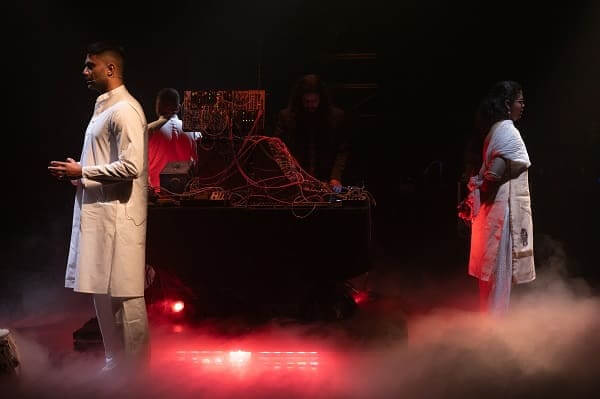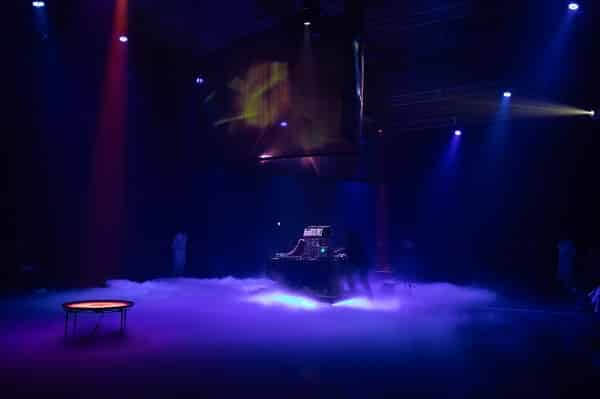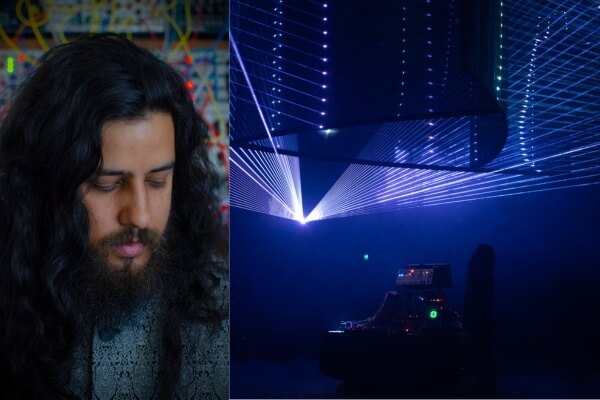As with many acts of worship, Vijay Thillaimuthu’s latest sonic performance for AsiaTOPA, ‘Oblation’ began with fire, first conceptualised during the time of the 2020 Black Summer bushfires. Oblation by Vijay Thillaimuthu
“Fire became a motif…I was thinking about these tragic events where precious, irreplaceable artifacts and documents were destroyed, and I was also thinking about rituals of the subcontinent where you sacrifice things to a sacred fire,” he says of the work’s origins.
“I was also thinking about the burning of the Jaffna Public Library; recently I asked my dad about my family tree, and he produced this document going back to the 15th century – apparently my ancestors were librarians.”
With a practice centered on creating transcendental experiences through analogue sound synthesis, in ‘Oblation’ Thillaimuthu evokes the burning explosion of a universe, bursts of light and sound reverberating through the Substation’s main gallery.
The audio-visual artist of Sri Lankan Tamil and Cornish descent was also inspired to reconnect with the chanting practices of his roots through this work, hoping to offer an ‘oblation’ to the ancient realm of his ancestors.

“The initial conception of this work came from thinking about my distance from my cultural heritage, and the Vedic chanting tradition where ultimately the specific pronunciation is what defines their divinity,” Thillaimuthu says.
“I wasn’t exposed to the rituals of my ancestry; instead, I’ve kind of developed my own quite disparate, sort of quasi-spiritual system – witnessing the physics of sound, through drone music and electronic exploration, [as a] form of meditation.”
Utilising lasers, projection and vibrations to forge a throughline to the ancients, ‘Oblation’ explores the connection between audio-visual mandalas and mantras; synthesiser as altar, it seeks to access the infinite in the resonance and geometry of live sound and visuals.
Equally, Thillaimuthu was drawn to the Carnatic music of his ancestry, collaborating with the Hari Sivanesan ensemble who bring live vocals and instruments to the mix.
“[Carnatic music is] something that’s been always kind of peripheral in my world of hearing, I’ve always been drawn to the sounds and the rhythmic quality of Carnatic music,” he says.
“Previously I felt like I almost don’t have the authority to work in this realm with the sacred nature of traditional music; I’ve always been interested but haven’t really had an entry point exactly.” Oblation by Vijay Thillaimuthu
Of course, as an electronic musician, much of the groundwork of the Carnatic style already existed in Thillaimuthu’s musical lexicon.
“All the things that are exciting to me about Carnatic music – drones, improvisation, tonality, the non-Western scale that’s closer to harmonic series, that’s all been in my work without that formal training,” he explains.

Through a process of improvisation, the Hari Sivanesan ensemble and Thillaimuthu have found the harmony between electronic and traditional sounds; the ensemble chants the Gayatri Mantra, the reverence and resonance then taken up by electronic drones.
“Traditionally these worlds are very separate – electronic music is a contemporary and emergent language, then there’s the very old and very rich history of Carnatic music – these things are sort of worlds apart,” says Thillaimuthu. “But I’ve just been really pleased and excited at the way that we’ve been able to bring the two worlds together.”
He hopes audiences too will feel the union of cultures and realms.
“I had this idea of [Oblation] being a transportive and transformative space, a space to be immersed and feel something beyond the preconceptions of reality – connecting to the ancient traditions of my cultural heritage and feeling accepted and almost part of this lineage.” Oblation by Vijay Thillaimuthu
More about AsiaTOPA here
READ ALSO: Tushar Singh and the new golden Indie(an) age of music




